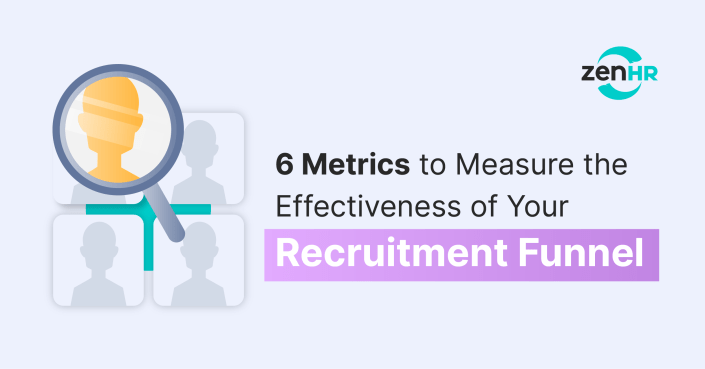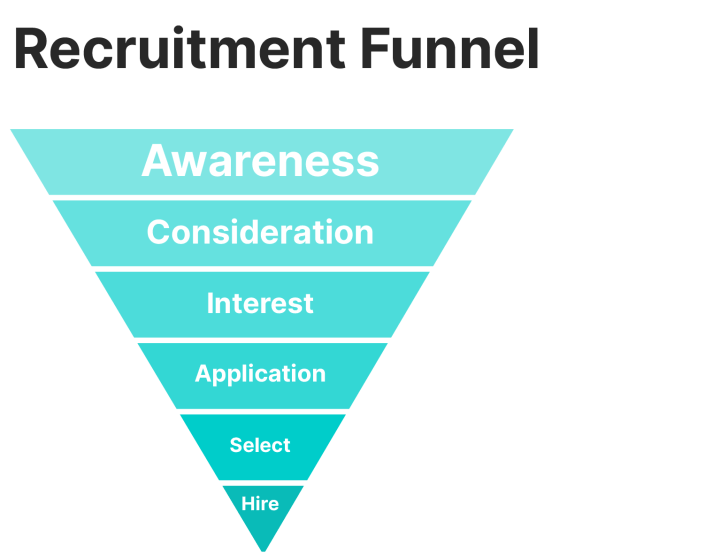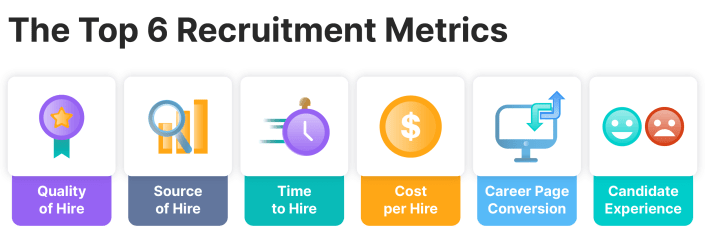
Assessing the performance of your recruitment funnel is crucial in order to ensure that your hiring process is running efficiently and that your company is on the right path to attracting the best talent. Your recruitment funnel is important as it’s comprised of all the stages that, active and passive, potential candidates go through before getting hired.
Similar to sales, your company can also use a funnel to make sure they attract and hire the best talent. The recruitment funnel can provide you with a continuous pipeline of applicants and help you find the right candidate to fill each position in your company when managed well. However, in order for this funnel to produce your desired results, you must keep track of its performance and measure and optimize each step.

The Recruitment Funnel Structure
The structure of a recruiting funnel can vary, but below you’ll find the typical six-step structure:
- Awareness: potential candidates become aware of your company through your employer branding.
- Consideration: the potential candidates consider your company as a possible future employer (culture, benefits, projects).
- Interest: the potential candidates build interest in your company (follow it on social media, view posts, etc.).
- Application: the potential candidates apply for a job.
- Select: the applicants get through assessment tests and interviews.
- Hire: the best candidate gets offered the position and commits to the company.
It’s essential to focus on candidate engagement and build strong relationships with your talent pipeline at every stage. Your employer branding strategy/recruiting marketing is key to attracting qualified candidates, which composes the first three steps of the structure. The last three steps are all about an automated application process and efficient selection process, which are necessary to provide the best candidate experience.
Ways to Assess Your Recruitment Funnel
Here are some useful recruitment metrics every HR professional and recruiter should be tracking to improve your recruitment funnel and save time and money.

1. Quality of Hire
Your organization’s recruitment goal is to hire the best-quality people to drive business performance forward. Quality of hire is one of the best metrics for hiring managers in terms of importance. Quality of hire has a long-term impact on the business and on the overall quality of the staff.
Tracking this metric will help you determine if you are consistently hiring top performers or if your recruitment process is only delivering low and average-quality hires. Quality of hire isn’t a subjective measurement. It’s measured by defining factors that drive top performance for a particular role, then measuring quality through performance reviews, manager satisfaction surveys, and tracking retention.
2. Source of Hire
Monitoring where candidates are coming from can be very useful when recruiting. It shows you if your careers page is generating any clicks or whether candidates are coming from job boards, social media, referral programs, or any external recruitment agencies.
You can determine the source of hire through an efficient applicant tracking system (ATS), and with this metric, you can better handle recruiting expenses. You can spend money on channels that are bringing your company qualified people and spend less on channels that are not bringing any candidates, saving you money in the long run.
3. Time to Hire
The best candidates won’t wait forever, so it’s crucial to ensure that your recruitment process has an adequate time frame, or you may miss out on the top talent available. Research shows that 57% of job seekers lose interest in a job if the hiring process is lengthy.
Measuring time to hire gives you a better picture of how long it takes to fill specific positions, from the moment the job is open to the moment an ideal candidate gets hired. This will allow you to keep improving every step of your recruitment process by discovering and preventing any hindrances, leading to you hiring a lot better and faster.
4. Cost per hire
Cost per hire shows companies how much it costs to hire new staff, and measuring it provides you with a benchmark for driving recruitment costs down and helps you compose future recruitment budgets. Calculating your total internal and external recruiting costs delivers clear insight into your recruitment process. It’s essential to know your department’s costs well and use correct and precise data to calculate this metric. Only precisely calculating this metric will allow you to examine your cost per hire and identify in which ways you can optimize it.
5. Career Page Conversion
An appealing and user-friendly careers page is key to attracting candidates, but visitors don’t mean much if you don’t get applicants for your vacancies. How many visitors actually apply for a job through your website? To know if your careers page efficiently draws in new applications, it’s critical to monitor its conversion rate.
You can find your career page’s conversion rate through an applicant tracking system (ATS) as well. Your conversion rate will help you assess whether you need to improve usability, rewrite job descriptions, add more pictures and/or videos, and more to attract more applicants.
6. Candidate Experience
The candidate experience you provide is pivotal, as it can either attract more candidates or drive them away from your company. Measuring an applicant’s satisfaction level with your application process is crucial to understanding what aspects of your recruitment need to be improved. There are many different ways to assess how candidates feel about your recruiting, including sending surveys or asking for feedback during different stages of the recruitment process. No matter how you choose to do it, it’s important to look at the feedback you’ve received and work on the aspects that need more improvement.
Automate Your HR Processes Now

Amanee Hasan
Amanee Hasan is a Senior Content Writer at ZenHR, an award-winning and top-rated HR solution that offers world-class HR software services in the MENA region. Her main focuses are SEO, UX writing, copywriting, and creating content highlighting the latest HR trends, and gives organizations and individuals the tools they need to create successful work environments where people thrive.



